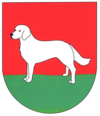Parihuzovce
| Parihuzovce | ||
|---|---|---|
| coat of arms | map | |

|
|
|
| Basic data | ||
| State : | Slovakia | |
| Kraj : | Prešovský kraj | |
| Okres : | Snina | |
| Region : | Horný Zemplín | |
| Area : | 9.520 km² | |
| Residents : | 21 (Dec. 31, 2019) | |
| Population density : | 2 inhabitants per km² | |
| Height : | 445 m nm | |
| Postal code : | 067 35 ( Pčoliné post office ) | |
| Telephone code : | 0 57 | |
| Geographic location : | 49 ° 7 ' N , 22 ° 12' E | |
| License plate : | SV | |
| Kód obce : | 520632 | |
| structure | ||
| Community type : | local community | |
| Administration (as of November 2018) | ||
| Mayor : | Ján Stanko | |
| Address: | Obecný úrad Parihuzovce č. 46 067 35 Pčoliné |
|
| Statistics information on statistics.sk | ||
Parihuzovce (Hungarian Juhos - until 1907 Parihuzóc , Russian Паризiвцi / Parisiwzi ) is a municipality in Okres Snina ( Prešovský kraj ) in the far east of Slovakia with 21 inhabitants (as of December 31, 2019) in the traditional Zemplín landscape .
geography
The municipality is located in the western part of the Bukovské vrchy Mountains in the headwaters of the Pčolinka river , near the state border between Slovakia and Poland . The center of the village lies at an altitude of 445 m nm and is 16 kilometers away from Snina .
Neighboring municipalities are Hostovice in the north, Stakčín in the east, Pčoliné in the south and Čukalovce in the west.
history
Parihuzovce was first mentioned in writing in 1567 as Parihuzoc and belonged to the Humenné estate , from the 17th century it was owned by the Szirmay family and in the 19th century by the Mednyánszky family . In 1787 the village had 38 houses and 233 inhabitants, in 1828 there were 45 houses and 344 inhabitants who were employed as shepherds, woodcutters and farmers. Many residents emigrated between 1880 and 1900.
Until 1918, the place in Semplin County belonged to the Kingdom of Hungary and then came to Czechoslovakia or now Slovakia.
population
According to the 2011 census, Parihuzovce had 33 residents, including 23 Slovaks , seven Russian and one Ukrainian . Two residents gave no information about their ethnicity .
15 residents supported the Orthodox Church, 10 residents the Greek Catholic Church, two residents the Roman Catholic Church and one resident of the Evangelical Church AB. One resident had no denomination and four residents had no denomination.
Buildings
- Greek Catholic Church of the Birth of the Virgin Mary in mixed baroque-classicist style from 1801
Individual evidence
Web links
- Entry on e-obce.sk (Slovak)


